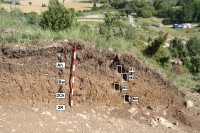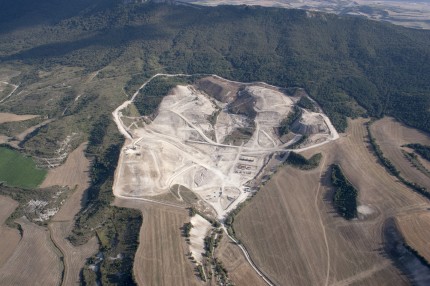 Archaeologists from the University of the Basque Country have unearthed the tell-tale signs of viticulture dating to the 10th century at the archaeological site of Zaballa, in the Álava province of Basque Country, northern Spain. Zaballa is one of 300 rural settlements in the Álava region that were deserted hundreds of years ago. It’s the one that has been most thoroughly excavated and published.
Archaeologists from the University of the Basque Country have unearthed the tell-tale signs of viticulture dating to the 10th century at the archaeological site of Zaballa, in the Álava province of Basque Country, northern Spain. Zaballa is one of 300 rural settlements in the Álava region that were deserted hundreds of years ago. It’s the one that has been most thoroughly excavated and published.
Discovering the history of this remote, rural site is a challenge because there is very little written documentation and few surviving structures or archaeological materials. The only stone building was the 10th century church while peasant dwellings have long since disappeared. Not even pottery has been found because there was a general dearth of such daily use items in the archaeological record of the Basque Country during the early Middle Ages compared to other periods. Recent agricultural use of the land has also damaged the site.
This discovery, therefore, is of particular interest to archaeologists since it provides new information about the way the land was used and provides a glimpse into the unrecorded social history of its occupation.
“Archaeo-botanical studies of seed remains found in the excavations and pollen studies have provided material evidence of the existence of vine cultivation in a relatively early period like the 10th century,” explained [Juan Antonio Quirós-Castillo, director of the University’s Cultural Heritage and Landscapes Research Group]. This evidence is also supported by the metal tools discovered and which had been destined for this very use, and the study of the agrarian spaces, “which owing to the nature of the crop spaces built and the agrarian practices developed, they are not compatible with cereal crops but they are with vines,” he added.
Zaballa was occupied beginning with one small farm in the 6th century. That developed into a peasant village in the 8th century. An aristocratic family appears to have taken control in the second half of the 10th century, marked by the construction of a stone church in the village center. This is confirmed by the scant documentary evidence we do have of Zaballa written in 1087 that describes a monastery, probably the nearby Saint Tirso monastery, founded by lordly Castilian family of Tello Muñoz. The village was soon rebuilt in the neighboring valley while around the church large silos were built to collect the percentage of the peasants’ agricultural product claimed by the ruling family. The silos suggest grain cultivation. The discovery of the earlier vineyards points to a major reorganization of Zaballa’s planting culture.
There are no other buildings found in the area that indicate the presence of the family in the area in the 11th and 12th centuries, just a hoard of 30 coins and some jewelry from the late 11th century, so it seems likely that the lords were absentee landowners. In the 13th century the village was partially abandoned as the aristocracy streamlined its agricultural output, possibly to increase revenues during an economic downturn. Some of the population probably moved to the new towns growing in the region. By the beginning of the 15th century, Zaballa was under the control of the monastery of Badaya and within a few decades the monks evicted the remaining villagers so they could reorganize the land under their own rules. That was basically the end of the human occupation of the settlement, except for a short spurt at the end of the 16th and beginning of the 17th century.
Almost all of this information is the result of archaeological study, and even though it seems like a relatively obscure pursuit given the tiny size of the settlement and its long-since abandonment, it paints a portrait of people who lived and worked in the area for nearly a thousand years but never made it into the historical record.
In Quirós’ view, these microhistories constitute small windows into the past that allow one to analyse relatively complex historical processes directly, bottom upwards, “in other words, to see how the peasant community itself gradually adapts to the political and economic changes that take place in the medieval era and later.”
What is more, the analytical study of these places of production allows one to abandon those more traditional points of view of history which “conceptualize the high medieval periods as a time of technical simplification, as a meagre period in economic terms, since they point to considerable social and economic complexity. Specifically, it has been possible in these studies to see that there are various important moments in the Basque Country, 5th to 6th centuries and 10th to 11th centuries, which were decisive in the construction of our landscapes.”
